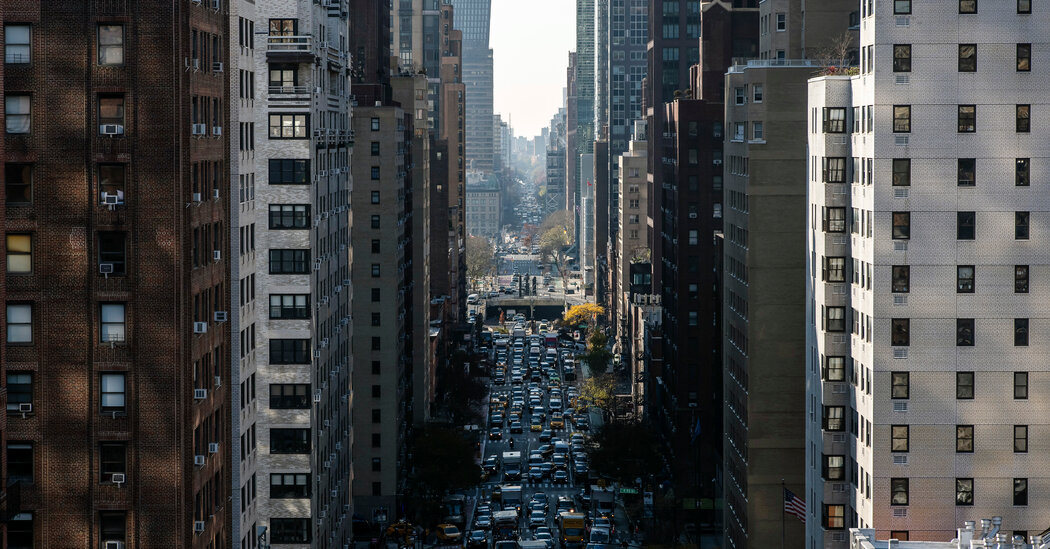Good morning. It’s Tuesday. James Barron is off this week. Today we’ll look at efforts to persuade Gov. Kathy Hochul to approve a modified version of New York’s decades-in-the-making congestion pricing plan, one month after she halted it. The program was supposed to have gone into effect on Sunday, when the governor was raising eyebrows by wearing an M.T.A. T-shirt to the New York City Pride March.
Gov. Kathy Hochul shocked many New Yorkers — and pleased some in the suburbs — when she pulled the plug on congestion pricing on June 5.
Hochul paused the plan indefinitely because she said it could hurt the economy, but her last-minute decision blew a multibillion-dollar hole in the budget of the state’s long-suffering Metropolitan Transportation Authority.
Last week, staff members at the authority outlined cuts in capital programs that totaled $16.5 billion, including the suspension of plans to upgrade crumbling signal systems, to expand the Second Avenue subway and to make more stations accessible to passengers with disabilities.
Now some lawmakers are trying to persuade the governor to resurrect the plan, which would charge motorists for driving in Manhattan below 60th Street, by lowering the proposed $15 toll.
“I’ve personally urged the governor to mend it, not end it,” Brad Hoylman-Sigal, a state senator, told my colleagues Dana Rubinstein and Grace Ashford. He represents a district in Manhattan that lies mainly within the congestion zone.
He said there “could be an appetite among my colleagues to adjust the toll and other features of congestion pricing while approving additional revenue to make up the shortfall to the M.T.A., but only if the program is allowed to proceed.”
Adjusting the toll is easier said than done.
The $15 figure was reached by working backward from the congestion pricing law passed in 2019. That law required the program to raise enough money to support $15 billion in debt, which works out to $1 billion.
In order to raise $1 billion, the authority’s Traffic Mobility Review Board recommended that the peak charge for many drivers entering the zone be set at $15.
Because that $15 billion target was written into the law, “we didn’t have any choice” when it came time to set the toll, said Kathryn Wylde, the chief executive of the Partnership for New York City, a business group, and a member of the traffic mobility board.
So a way to lower the toll, then, is to amend the state law. Then the agency could set a new toll by working backward from a new target.
But it is not clear that Hochul would be open to doing any of that. And even if she were, it is also not clear when it could even happen.
Only the Legislature can change the law, and it is not scheduled to meet again until January 2025. Hochul has the power to call lawmakers back to Albany for a special session, but she would be unlikely to do so without assurances of broad support from legislative leaders.
Would any of that even be a good idea?
Some people who have devoted their careers to congestion pricing, which was first proposed for New York in 1952, said no.
The whole point of the plan is to discourage motorists from driving in the most crowded areas and to improve public transportation by raising money from those who do.
In short, drivers are supposed to view congestion pricing as an expensive deterrent. That is how the city would raise money and improve traffic. If the toll is lowered, the program might not succeed at either goal.
Sara Lind, the co-executive director of Open Plans, a nonprofit group that supports a more pedestrian- and cyclist-friendly city, said lowering the toll was “a terrible idea.”
“It’s just not enough money for what the M.T.A. needs,” she said. “In order for congestion pricing to work and become popular, you need it to actually reduce congestion.”
Weather
Expect a sunny day, with temperatures in the mid-80s. The evening will turn partly cloudy, with temperatures in the upper 60s.
ALTERNATE-SIDE PARKING
In effect until Thursday (Independence Day).
The latest New York news
METROPOLITAN diary
Spin city
Dear Diary:
I was walking home from an afternoon doctor’s appointment in Midtown when I suddenly felt as if the city was spinning all around me.
I tried to lean against some scaffolding in front of a building on Second Avenue, but it wasn’t enough to keep me upright. Everything was still spinning, and I heard myself calling out for help.
There was a woman with a dog a few yards away who was on her phone. I could hear her crying. She came over to me as I hit the ground.
“Are you OK?” we asked each other.
“Yes, but I need a minute to see if I can stand,” I said as a man who worked at a nearby building joined us.
I stood up and, embarrassed and dazed, thanked them both for their help. I explained that I was feeling fine and would be able walk the rest of the way home on my own.
The woman with the dog offered to accompany me to be sure I was OK, and I asked her again if she was all right because I had seen her crying.
“I was talking to someone who called to tell me Chita Rivera just died,” she said.
— Sue Weiner
Illustrated by Agnes Lee. Send submissions here and read more Metropolitan Diary here.
